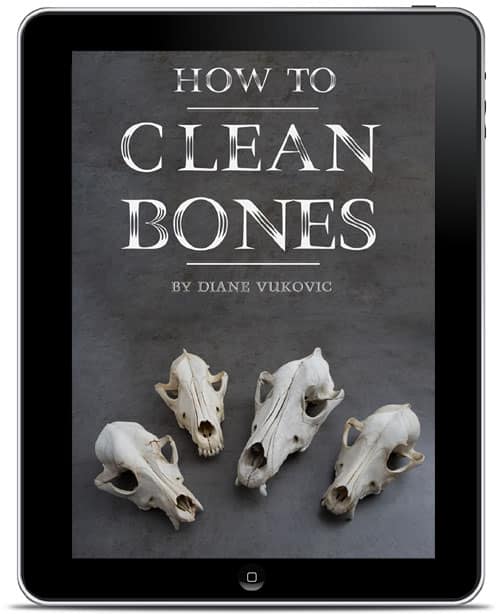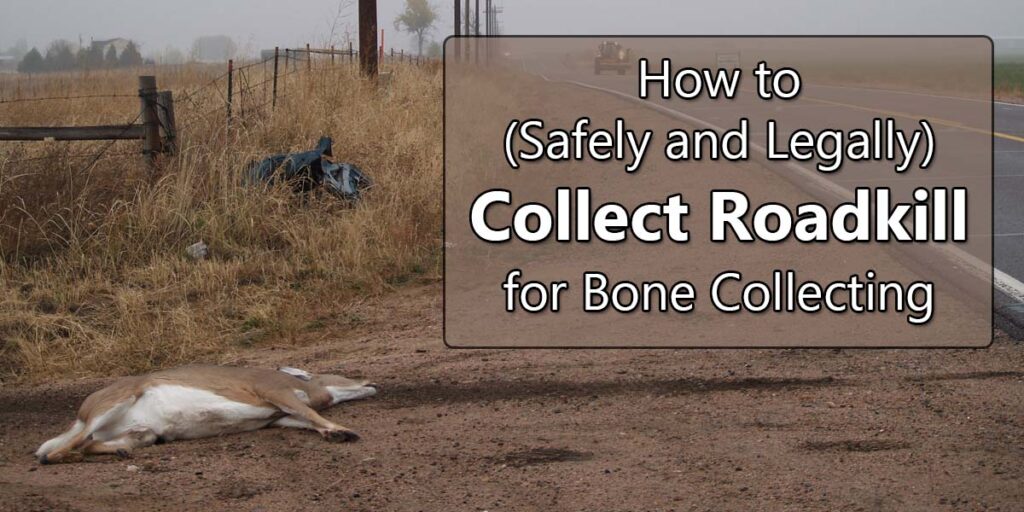Want to start collecting animal bones? Roadkill can be a great place to find bones for our collection. However, you can’t just grab dead animals off the side of the road. Here’s what you need to know to collect roadkill safely and legally, including what to put in your “roadkill kit.”
Also read:
By the way, I wrote an ebook about cleaning bones.
It covers everything you need to know about removing flesh, getting grease out, whitening and more.
You can buy it here 
Laws about Collecting Roadkill
For starters, make sure you know the laws about collecting roadkill. You’ll need to know permit requirements, laws about transporting across state lines, and laws about birds.
Permits for Collecting Roadkill
In many states, you need a permit to collect roadkill. It’s usually called a “wildlife salvage permit”. Unfortunately, a lot of these laws are written for people collecting freshly-killed animals for meat so they can be pretty restrictive. I guess they don’t want people gathering raccoons, etc. to eat!
For example:
- Montana wildlife salvage permits allow you to collect deer, elk, moose or antelope that was killed in a vehicular collision, but only if you did not hit it. You are required to take the entire animal. You can apply for the permit after collecting the carcass.
- Washington roadkill salvage permits are similar to Montana’s rules, but only for elk and deer.
- New Jersey Scientific and Salvage Collecting Permits are valid for one year. There are separate permits for exotic species and game species.
- Georgia requires a scientific collection permit for most animals. You can collect coyotes, armadillos, groundhogs, beaver, and some other animals without a permit.
In some cases, a hunting license will allow you to legally collect roadkill – but only in that animal’s legal hunting season. This isn’t always the case though, so check the laws carefully.
Transporting Dead Animals Across State Lines
A lot of states have laws which prohibit you from bringing dead animals across state lines. If it is allowed, you will have to meet strict rules – like ensuring that the animal is completely free of brain matter.
Roadkill Birds Laws
The Migratory Bird Treaty Act “prohibits the take (including killing, capturing, selling, trading, and transport) of protected migratory bird species without prior authorization by the Department of Interior U.S. Fish and Wildlife Service.”
There are also strict laws which prevent anyone except Native Americans from possessing eagle feathers.
Good Spots for Finding Roadkill
Now that you know the laws, you can start looking for roadkill animals. I don’t recommend collecting roadkill from the sides of highways. Not only is it dangerous for you, but the animal bones were probably completely destroyed by the impact.
Here are some best places to find roadkill.
- Gravel roads: You will usually find animals like skunk and foxes on these roads.
- Roads near water: The animals come to drink water, so you can find lots of different types of animals at these spots.
- Train tracks: Trains can’t slow down like cars, so it’s usually easier to find dead animals.
- Windy country or forest roads: Just be really careful that you don’t get hit by a car when gathering the roadkill. Make sure to park your car in a straight stretch of road.
Tip: In some areas, the County Sheriff Department keeps a list of people to call for collecting roadkill. Get yourself on this list!
Also read: Where to Find Animal Bones
Collecting Roadkill Safety
So long as you follow some general safety rules, collecting dead animals from the road is safe. Here are the guidelines.
- MAKE SURE THE ANIMAL IS ACTUALLY DEAD. An injured animal can be particularly dangerous. If it’s not obviously dead, approach the roadkill slowly to look for signs of movement (though sometimes maggots inside the carcass can make it move). Poke it with a long stick and see if the animal reacts.
- Don’t collect animals with signs of sickness. Such as foam around the mouth or snout, lots of drool, or blood in the mouth with no other damage.
- Never touch roadkill with your bare hands. Use gloves or bags instead.
- Wear PPE when cutting up roadkill. You’ll want a face mask and goggles. Otherwise you risk fluids or airborne droplets getting into your body. For example, you can catch bovine tuberculosis by breathing it in.
Roadkill Kit Supplies List
Serious bone collecters keep a “roadkill kit” in their car. This includes the supplies you need to collect roadkill without making a mess or exposing yourself to disease.
Depending on the type and condition of animal you find, not all of these supplies will be necessary for collecting roadkill. However, I advise you to have all of it in your vehicle. Otherwise you might not be able to take a good find home with you simply because you didn’t have the right supplies with you.
- Gloves: Ideally heavy-duty ones so they don’t tear when you pick up the carcass
- Trash bags: You’ll want many of them, in many sizes.
- Tarp: Sometimes it makes more sense to wrap the roadkill in a tarp. Like when I found an old cow vertebrae and ribs. Since there wasn’t any flesh left and the ribs would have ripped through a trash bag, I just wrapped it in a tarp. If you have a truck, you can also just put dead animals on a tarp in the back.
- Duct tape and rope: For sealing bags or tarps closed
- Sealable container: Such as a Styrofoam cooler or a plastic bin. This is where you put the wrapped dead animal so the stink doesn’t escape into the car. It also helps keep fluids contained so they don’t leak into your car.
- Newspaper: You can use this to pad any areas which are poking out so they don’t tear through the bags.
- Shovel: Sometimes the dead animal is really decomposed and it’s really gross to pick up, even with gloves on. You can then use the shovel to scoop it into the trash bags.
- Hand sanitizer: Immediately sanitize your hands after removing your gloves.
- Knife, hack saw, axe and/or loppers: These are useful if you only want to take part of the animal or if the animal is very large and you need to chop it up so it will fit in the bags.
- Paper towels: For wiping off your knife/tools after cutting apart the animal
- PPE: This includes a face mask, goggles and rubber boots. You should wear these any time you cut up roadkill. It’s also smart to wear them when handling rotten roadkill in case it explodes on you! Rubb
- Change of clothes: In case you get nasty fluids on you.
- Can of Raid: Or other hardcore bug spray
Note: A lot of these things you should have in your vehicle anyway in case of accidents. Even before I collected roadkill, I always had a change of clothes, tarp, shovel…
Instructions for Gathering Roadkill
- Find a safe place to park. Don’t park at bends in the road!
- Check that the animal is actually dead.
- Prepare your supplies. You don’t want to have to touch supplies once you’ve touched the dead animal. You’ll need to:
- Get out your hand sanitizer and open the bottle.
- Open two trash bags which are big enough to fit the carcass
- Also open a small bag for throwing away your gloves when you are done.
- Pre-tear a few pieces of duct tape and/or rope.
- Put your gloves on.
- If there are any pokey parts on the carcass (such as antlers), wrap them in newspaper and secure it in place. It’s tricky to use duct tape with gloves on, so it’s better to use rope.
- Put your hands inside one trash bag. Grab the carcass (preferably by the feet). Turn the bag over so the carcass is inside. This is the same method you’d use for picking up dog poop.
- Tie the bag shut and then put it inside the second trash bag.
- Use duct tape to secure the second trash bag closed.
- Put the bagged roadkill into the cooler.
- Sanitize your hands.
Tips for Cutting Up Roadkill
Sometimes you need to cut up roadkill, such as if you only want one part of the animal or it’s too big to fit in your trash bags. But, warning…
Animals fill with gas when they die. If you start hacking up the roadkill, it can EXPLODE nastiness all over you.
How can you avoid this? For starters, don’t just start chopping into the roadkill. If the animal is bulging, make a small hole to release the gas first. A swarm of flies or maggots might come out too!
Avoid stepping on the animal’s body while cutting it apart. If you must step on the animal, then make sure you are wearing rubber boots. It’s better than having your entire sneakers sink through rotten flesh. The smell will not wash away easily!
Preventing Bugs from Roadkill
Roadkill can have all sorts of nasty insects and bugs on it. Think maggots, fleas, ticks… You don’t want these bugs to get into your car, home or workshop.
To prevent infestation, do one (or more) of these steps:
- Make sure the garbage bag is really well-closed. You’ll need to double bag it and check that there aren’t any holes in the bag.
- Before you close the garbage bag, spray tons of Raid into the bag. Wait at least a few hours before opening the bag.
- Freeze the animal before you start working on it. This is recommended if you need to bring the roadkill inside (such as if you don’t have a yard) or can’t start working on it right away. You’ll need to freeze the carcass for at least one week though to kill all insects and their eggs.
Did I miss something? Let us know your tips about collecting roadkill in the comments section below!
Sources:
https://www.taxidermy.net/threads/283350/
https://www.reddit.com/r/bonecollecting/comments/hz8f0c/my_process_for_harvesting_road_kill_through/
https://www.reddit.com/r/vultureculture/comments/ufbjti/first_time_picking_up_roadkill_tips/
https://www.fws.gov/eaglerepository/factsheets/possessionofeaglefeathersfactsheet.pdf
https://www.reddit.com/r/vultureculture/comments/ykmdkv/anyone_here_pick_up_roadkill/
https://www.reddit.com/r/AskReddit/comments/gpkjn/looking_to_harvest_animal_skulls_from_roadkill/
https://www.reddit.com/r/Taxidermy/comments/i0otlz/how_to_remove_flesh_off_bone_safely/
https://www.reddit.com/r/Maine/comments/6u6568/i_collect_roadkill_help_me/
Image credit:
“Roadkill deer tractor pa212353” (CC BY-SA 2.0) by lostinfog













2 Comments
Kaitlyn
February 10, 2023 at 3:16 amI don’t have a freezer I can dedicate for this, is there an alternative?
Diane
February 12, 2023 at 7:47 amYou don’t have to put it in the freezer. That’s only if you need to start working on the carcass in a garage or other indoor space. You can just spray Raid into the bag when you collect the roadkill. Or, if you don’t want to do that, make sure the bags are REALLY well closed so insects don’t get into your vehicle.
If you don’t freeze or use Raid, start removing the flesh immediately when you get home. If you have a yard, the burial method is usually best and “cleanest”. Read this post for more on that: /remove-tissue-cleaning-animal-bones/